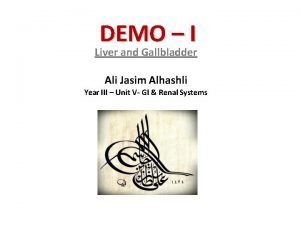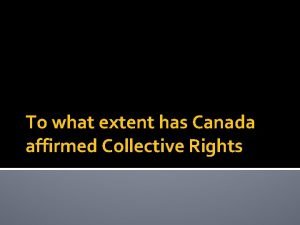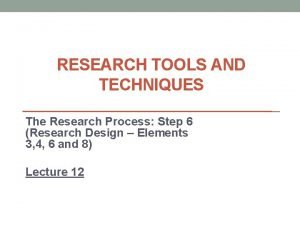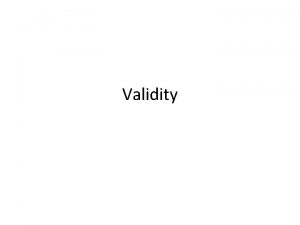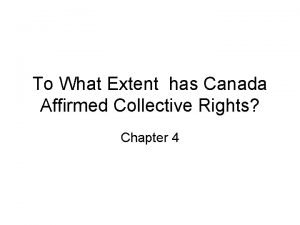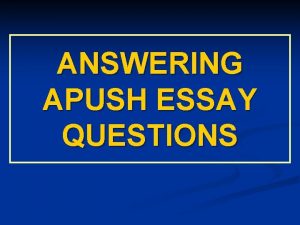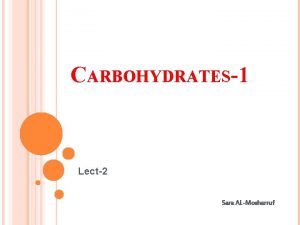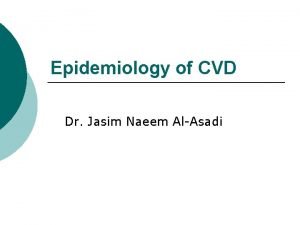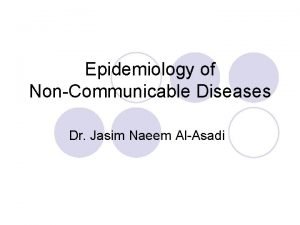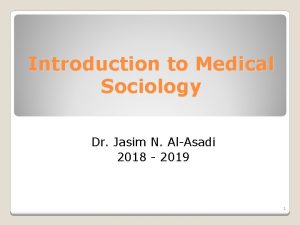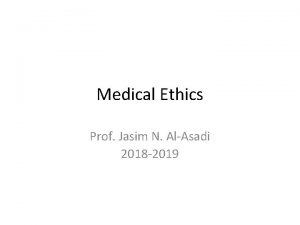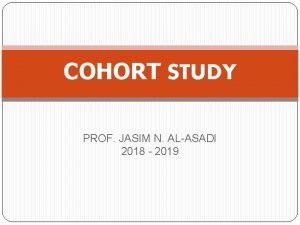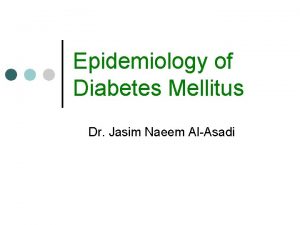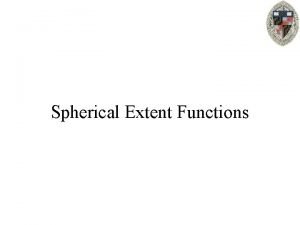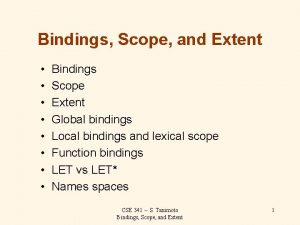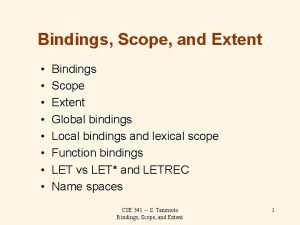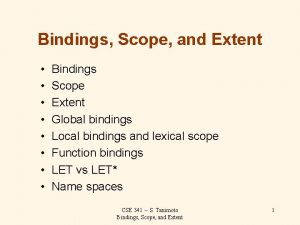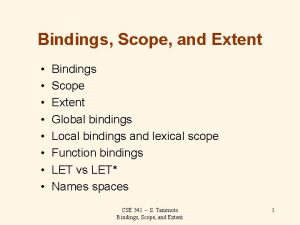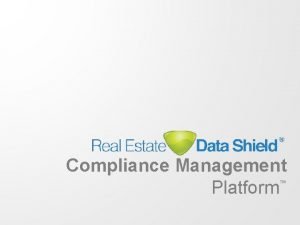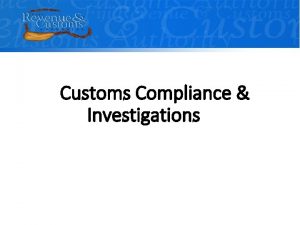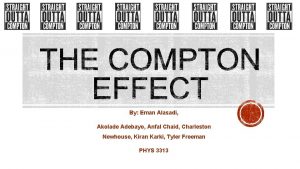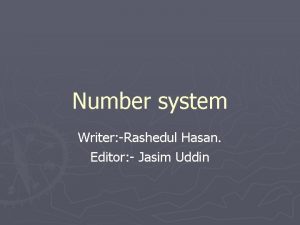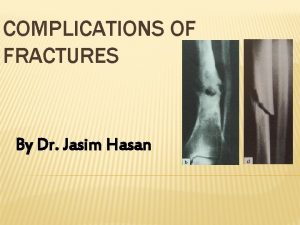Compliance Dr Jasim N AlAsadi Definition The extent







































- Slides: 39

Compliance Dr. Jasim N. Al-Asadi

Definition ▲ The extent to which patients carry out the treatment (drugs, instructions, …etc) prescribed by doctors. ▲ WHO: the extent to which a person’s behavior (taking medication, following a diet, and/or executing lifestyle changes) corresponds with agreed recommendations from a health care provider. ▲ Today, health care professional prefer to talk about “adherence” to a regimen rather than “compliance”.

Adherence vs Compliance ▲ Compliance connotes unilateral decision making and expectations that, if the physician prescribes it, the patient should take it. i. e. “compliance” suggests that the patient is passively following the doctor’s orders. Patient should not be passive. Treatment plan should be based on a therapeutic alliance or contract between the patient and the doctor. Noncompliers seen as deviants, incompetent, unable to follow instructions. ▲ Adherence connotes a mutually agreed upon plan between patient and physician that patients can follow and doctor will support. It implies an active role, in collaboration with prescriber, self-motivated behavior to adhere to treatment advice.

▲ Poor compliance to treatment of chronic diseases is a worldwide problem of striking magnitude – Average of 50% of patients with chronic diseases in developing countries follow treatment recommendations [WHO estimates in 2003] – Ex. Non-compliance accounts for a significant percent of admissions in patients with heart failure – Adherence is greater during first 6 months of 1 follow up and drops thereafter

Medication adherence 22% of U. S. patients take less of the medication than is prescribed American Heart Association: Statistics you need to know. http: //www. americanheart. org/presenter. jhtml? identifier=107 Accessed November 21, 2007.

Predictors of compliance ▲ 1 - Doctor’s therapeutic intentions when prescribing drugs. ▲ 2 - Patient’s expectation on drug prescribing. ▲ 3 - Doctor’s perception of these expectations.

Examples ▲ Stimson (1979): patients expect prescriptions at about half of the consultations, whereas the majority of doctors estimate that this happens much more frequently (80%). ▲ Cartwright & Anderson (1981): proportion of patients who thought that their doctors were too inclined to give prescriptions rose from 2% in 1964 to 7% in 1977.

Methods of assessing compliance ▲ 1 - Indirect: - Checking whether prescriptions are made up. - Biochemical tests, Blood tests or urine tests. Putting a marker in the drug which shows up in the patient’s urine or stool. Accurate, but Expensive, Inconvenient. The patient could easily take the required dose just before the appointment with the doctor. Also one has to take account of a patient’s metabolism or biochemical response to the prescribed drugs.

Methods of assessing compliance - Counting the pills that are leftover and checking whether prescriptions are repeated at an appropriate interval. The problem is; patients can throw the pills away! - Mechanical methods: Device for measuring the amount of medicine dispensed from a container. Expensive and not foolproof. - Therapeutic outcome. We can not be sure that the recovery from an illness has been owing to the treatment. It could have been spontaneous, or perhaps the patient is suffering less stress. Health worker estimates may be unreliable.

Methods of assessing compliance ▲ 2 - Direct: - Interrogating the patient about taking drugs, or self report of taking drugs. Self report Problem is that patients overestimate their compliance level.

▲ If multiple readings are taken by using several of the methods that check compliance, then a more accurate picture of the patients' compliance can be made. ▲ If a patient is shown to be non-compliant by several different measures then we can be almost certain that the subject really has not complied.

Causes of non-compliance ▲ 1 - Lack of comprehension: studied by e. g. relating daily dose as described by the patient to that recommended by the doctor. This can be affected by: - Clarity of instructions - Dosage and multiplicity of administration - Social class, age, and mental test score.

Causes of non-compliance ▲ 2 - Effectiveness of treatment and possible side effects: A basic assumption about compliance studies is that compliance matter. Compliance certainly matters when it comes to interpreting clinical trails, but is it established that treatment would do more good than harm to those who don not comply?

Example mortality among patients who use Clofibrate in comparison with those on placebo treatment Treatment group Adherence Clofibrate Placebo (% of mortality) < 80% 24. 6% 28. 2% 80% & more 15% 15. 1% Total 18. 2 19. 4%

▲ There is no much difference in this example, so we have to increase the compliance on effective drug. This is called [compliance matter] between those who comply and those who do not comply. ▲ Therefore, It is very essential to compare the compliance, to assess the effectiveness of the drug.

Factors Affecting compliance ▲ Patient characteristics: Emotional and biological functioning, readiness to comply, age, education. ▲ Medication factors: Pill burden, side effect, Timing of dose. ▲ Health care or medical system: Doctor-patient relationship, Contextual aspects of medical setting (Inpatients vs. out patients), and Provider communication, treatment education, cost of care, access to care ▲ Disease & regiment considerations: Chronicity, Complexity, and Immediate & future consequences of compliance. ▲ Community/environment ▲ Ex. Stigma, transport ▲ Family system: (knowledge, support, problem solving skills)


Factors that increase compliance include ▲ Positive physician-patient relationship. ▲ Patient feeling ill ▲ Limitations of patients activities due to disease state ▲ Written instructions for taking medication ▲ Acute illness ▲ Simple treatment schedule ▲ Short time spent in waiting room ▲ Physician recommending one change at a time ▲ Benefits of care outweigh costs ▲ Peer support

Causes for poor compliance include ▲ Dosing frequency ▲ Forgetfulness ▲ Real or perceived side effects / perceived lack of effect ▲ Few symptoms ▲ Number of pills ▲ Chronic illness ▲ Type of medication ▲ Purpose of treatment is not clear ▲ Complexity of regime or unclear instructions for administration ▲ Cost of drugs

Detection of non-compliance ▲ 1 - Clinical judgement: it is not only useless but may go in the wrong direction. Example Pill count Physician estimation of compliance Total Sensitivity = 2/21 x 100= 9. 5% Specificity= 43/50 x 100= 86% Positive Predictive value= 2/9 x 100= 22. 2% low high total Low 2 7 9 high 19 43 62 21 50 71

Detection of non-compliance ▲ 2 - Maintaining attendance at scheduled appointments: It needs a good practice and set up. ▲ 3 - Monitoring achievement of the treatment target: It helps to focus research on those who have not reach the treatment target.

Pill count Achievement of the treatment target a = Group to be identified b = Inadequate treatment c = Wrong diagnosis d = Ideal low high No (Not at target) a b Yes (at target) c d

▲ 4. Searching for therapeutic results or side effects: High compliance with an inadequate regimen will result in neither side effects nor achievement of treatment goal. ▲ 5. Pill count ▲ 6. Drug level measurement: Expensive, cumbersome, unavailable. ▲ 7. Asking the patient: To maximize the sensitivity of this approach, the admission of not taking drugs should be made socially acceptable.

Summary ▲ Track down patients who have missed appointments. ▲ Focus on those who have not reach the treatment goal. ▲ Using a non-threatening interview of those who do not attain treatment goals.

Improving low compliance ▲ Logical & ethical requirements to improve compliance: 1. Diagnosis must be correct 2. The disease must be non trivial 3. Therapy must be efficacious 4. Compliance intervention must be efficacious 5. Patient must be informed and willing

Examples of strategy to improve compliance ▲ For short term treatment 1. Give simple, clear instructions (in writing). • Verbal has 10% recall • Visual 20% recall • Combined shows up to 65% recall after 3 days! 2. Give injections better than pills. 3. Minimum number of doses per day should be prescribed.

▲ For long term treatment: 1. Increase supervision of non –compliance by more frequent visits, involve nurse, family, …etc. 2. Encourage high compliance. 3. Direct every day’s attention to compliance problem 4. Re-enforce good compliance when it occurs. 5. Don’t let up.

▲ With referrals: 1. Tell the patient what to expect 2. Help the patient make a convenient appointments.

Health Effects of Non-compliance ▲ Increased morbidity (sickness) ▲ Treatment failures ▲ Exacerbation ▲ More of disease frequent physician visits ▲ Increased ▲ Death hospitalizations

Statin therapy adherence demonstrated to improve three specific outcomes West of Scotland Coronary Prevention Study (WOSCOPS). Compliance and adverse event withdrawal: their impact. Eur Heart J 1997; 18: 1718 -1724

Economic effects of Non-compliance ▲ Increased absenteeism ▲ Lost productivity at work ▲ Lost revenues to pharmacies ▲ Lost revenues to pharmaceutical manufacturers

Poor adherence increases total health care costs Hypertensive Patients and Total Annual Costs Smith DL. The effect of patient noncompliance on health care costs. Medical Interface 1993: April; 74 -84

Benefits of improved compliance: ▲ For: – Patients - better outcomes and quality of life – Practitioners – healthier, more loyal patients – Managed care - lower total Health Care expenditures – Pharmaceutical Industry - increased sales

Practical Ideas § Alarm clock § Mobile phone § Treatment supporter § ‘Normalize’ in to daily life § Pill box § Colour-coded cards (e. g. TV programme, radio, meals)

Interventions ▲ Educational approaches ▲ Supervision by health care professionals

Interventions ▲ Visual cues or reminders ▲ Self-monitoring ▲ Incentives

Interventions ▲ Social support ▲ Reducing barriers & problem-solving

▲ REMEMBER!!! Ø Only prescribe drugs that are needed Ø Try use medications that can be given once daily Ø Continually review medication and progress of patient Ø Try match a simple regime to daily routine Ø Try to involve family/friends Ø Stress necessity of compliance always!!

Perceptions & Practicalities Model of compliance Unintentional noncompliance Capacity & resources Practical barriers Intentional noncompliance Motivational Beliefs/preferen ces Perceptual barriers
 Surface anatomy of liver
Surface anatomy of liver To what extent has canada affirmed collective rights?
To what extent has canada affirmed collective rights? Biggest british empire
Biggest british empire Non contrived setting
Non contrived setting What is the nature and extent of juvenile delinquency
What is the nature and extent of juvenile delinquency Face validity examples
Face validity examples To what extent should we embrace globalization
To what extent should we embrace globalization Should internationalism be pursued
Should internationalism be pursued To what extent has canada affirmed collective rights
To what extent has canada affirmed collective rights Should nation be the foundation of identity
Should nation be the foundation of identity Apush essay prompts
Apush essay prompts To what extent should we embrace nationalism
To what extent should we embrace nationalism Is resistance to liberalism justified
Is resistance to liberalism justified Which bird can rotate its neck backwards to a large extent
Which bird can rotate its neck backwards to a large extent Beowulf study guide answers
Beowulf study guide answers Noncontrived
Noncontrived To what extent can a damaged brain reorganize itself
To what extent can a damaged brain reorganize itself To what extent adverbs
To what extent adverbs Wide extent
Wide extent Locally managed tablespace
Locally managed tablespace Analyse the extent
Analyse the extent Introduction of carbohydrates
Introduction of carbohydrates Hình ảnh bộ gõ cơ thể búng tay
Hình ảnh bộ gõ cơ thể búng tay Ng-html
Ng-html Bổ thể
Bổ thể Tỉ lệ cơ thể trẻ em
Tỉ lệ cơ thể trẻ em Gấu đi như thế nào
Gấu đi như thế nào Tư thế worm breton là gì
Tư thế worm breton là gì Chúa yêu trần thế alleluia
Chúa yêu trần thế alleluia Môn thể thao bắt đầu bằng chữ f
Môn thể thao bắt đầu bằng chữ f Thế nào là hệ số cao nhất
Thế nào là hệ số cao nhất Các châu lục và đại dương trên thế giới
Các châu lục và đại dương trên thế giới Công của trọng lực
Công của trọng lực Trời xanh đây là của chúng ta thể thơ
Trời xanh đây là của chúng ta thể thơ Mật thư tọa độ 5x5
Mật thư tọa độ 5x5 Phép trừ bù
Phép trừ bù độ dài liên kết
độ dài liên kết Các châu lục và đại dương trên thế giới
Các châu lục và đại dương trên thế giới Thể thơ truyền thống
Thể thơ truyền thống
